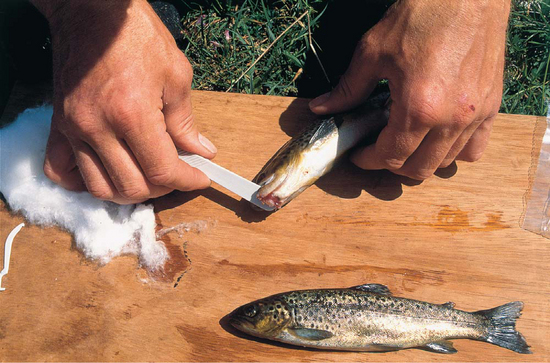Chapter 14 Selected Fish Diseases in Wild Populations
Fishing is a vital source of income for local communities and a popular pastime in many countries of the world. An initial report of wild fish health problems usually originates from the fishing community. The majority of reports therefore concern fish of economic or sporting interest. The most obvious indicator of health difficulties in wild fish populations is mass mortality, but decreased numbers, abnormal behavior, or visible gross external lesions in wild fish are also reported.
UNDERSTANDING THE AQUATIC ENVIRONMENT AND ITS EFFECTS ON FISH HEALTH
Veterinarians understand the concept that disease agents are influenced by environmental factors. Within many animal production systems, however, the relevance of environmental effects is often alleviated by attention to husbandry, housing, nutrition, and other disease prevention techniques. In the wild, environmental factors influence the occurrence of disease unabated, and this concept must be further considered in any investigation of wild fish health problems.2,3
Many natural processes affect the physical and biochemical parameters of rivers, lakes, estuaries, and oceans, and fluctuations may occur seasonally, diurnally, or tidally, depending on the parameters in question. Box 14-1 lists the main parameters that vary naturally in aquatic systems and have a role in the overall health of animals living in this environment. Populations of wild fish live in equilibrium in the presence of many disease agents. Interactions and equilibriums are a feature of the “big picture” within which the living animal strives to maintain homeostasis. Stressful changes in the environment allow pathogens to become established and to become detrimental to the health of the fish. Disease investigation involves the collation of information to ascertain which environmental and pathogenic elements have caused the problem.
DISEASE INVESTIGATION
History Collection
Record details of the person reporting the problem and ascertain the site of the problem accurately, with map references if possible. Some areas are remote, and because it is impossible to contain the site, changes often may occur before any investigation begins, and what is witnessed on one day may be different on another. Therefore you should obtain a good description of exactly what the initial reporter has seen. What is the obvious problem: dead fish, live fish swimming abnormally, lesions noted on live fish? When did the problem start? What type of fish are involved, and how many are affected? If the principal investigator cannot reach the site for some time, and if reporting personnel appear competent or are trained (e.g., fisheries staff), initial on-site data collection may begin immediately.
Site Examination and Data Collection
Collection of on-site data should begin as soon as possible after arrival. Box 14-2 lists some basic equipment that may be useful for such investigations.
Clinical Examination
In examining the affected population, note the general state of the fish. If they are dead, note any decay and changes in their general condition that may help in estimating the duration of the ongoing problem. Also note the physical appearance: gills flared, mouths agape, twisted spines, excess mucus, and gross external lesions. In live fish, note their color and fin position, and assess any unusual behavior, such as loss of equilibrium or attempts to exit water.
Gross Postmortem Examination and Sample Collection
Some tasks should be done on-site during the gross postmortem examination (Figure 14-1). Other samples may be appropriately stored for further laboratory testing. Parasitologic examinations and swabs for microbiologic culture provide more meaningful results when taken from fresh fish, so sample sick fish, which are humanely euthanized, on-site. If sick fish cannot be caught, sample the freshest dead fish.
Open the fish using a sterile technique, and look for any abnormal swellings, accumulations of fluid, hemorrhages, adhesions, or other lesions. Take swabs from the posterior kidneys and any visible lesions for culture. Make impression smears of individual organs and lesions for cytologic examination, where appropriate. A selection of tissues and visible lesions that include normal surrounding tissue should be placed in formalin for histologic processing and examination (Box 14-3). Collect further tissue samples, or freeze some whole fish, for toxicologic and viral testing (Box 14-4).




